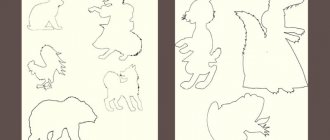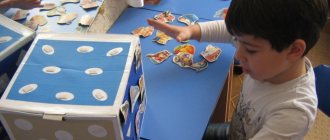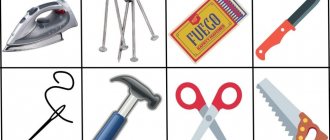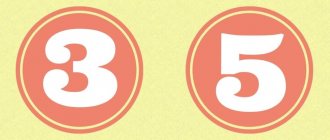Musical games for the younger group of kindergarten
Methodological development.
Musical games for younger preschoolers Author: Nadezhda Veniaminovna Zemlemerova, music director of MBDOU “Kindergarten No. 6 “Malachite” in the city of Cheboksary, Chuvash Republic.
This development will be useful for music directors and kindergarten teachers.
Can be used both in music classes and in leisure activities with younger preschoolers. Goal: Formation of motivation for musical activity; — development of musicality in children of primary preschool age. Objectives: - nurturing a child’s interest in the world of musical and non-musical sounds, elementary music-making;
- development in children of perception of musical and non-musical sounds; - enriching children's musical experience; — activation of children’s emotional reactions to music; — development of musical and game improvisations, performing skills and creative abilities in children. Junior group
“Guess the instrument” (A screen is installed, behind it there are musical instruments: bells, a drum, a rattle, a tambourine. The teacher reads a quatrain, calling the name of any child from the group, the Katya doll plays any musical instrument, the children guess
) The guys are playing, Let’s find out what it sounds like now, Play doll Katya!
Quickly, Olya, call me! “Quiet and loud palms” (Depending on the sound of the music, the children clap their hands either loudly or quietly)
We’ll play with palms, Loudly, loudly hit, One, two, three, don’t yawn, Loudly, hit loudly!
We'll play with our hands, Quietly, quietly, hit. One, two, three, don’t yawn, Quietly, hit quietly. “Rhythmic legs” (Children step to the rhythm of the music, now slowly, now quickly; at the same time, along with the steps, they knock with sticks)
We walk slowly, we raise our legs, we play with sticks, we hit each other.
We walk quickly, we raise our legs, we play with sticks. Let's hit together. “Children and the Bear” (Children walk around the entire hall, playing with rattles to cheerful music; when the bear appears, the music changes to marching music, the bear plays the drum; all the children hide from him and crouch)
The children went out for a walk to play with rattles, That’s how fun we are walking , We play rattles.
A bear came out with a drum, Boom-boom-boom, tram - there-there, All the guys hid, Here and there, here and there. “Musical mosaic” (Children are shown a picture with an image, a poem is told, the child chooses an instrument and portrays the one drawn in the picture.)
Here is a frog in the swamp, he lives very happily. Listen, guys, Kwa-kva-kva she sings!
The bear came out of the den, quickly run away, and when he began to roar, that’s how the little bear is! The rain is dripping on the roof, Knock-knock-knock, knock-knock-knock, Barely audible, barely audible, Knock-knock-knock, knock-knock-knock! The sparrows are cheerful, they start pecking at the grains, they don’t lag behind the others, they keep pecking, pecking, pecking. Here is a stream flowing, Apparently its path is far away, It is murmuring, splashing, trying to escape! “Funny balls” (To determine the contrast in music. For the first part of the music, the “balls” roll one after another or loosely, for the second part they bounce in place.) The
ball rolled, rolled along the path, We run like balls, These are the legs !
Suddenly our ball started jumping and jumping so merrily. We are like balls now. Let’s all jump together! “Little musicians” (Children play spoons for the first, fast part of the music, tambourines for the second, slow part). “Chickens and a fox” (The hens come out, peck the grains, clean the feathers. Then the fox runs out and catches the chickens: whoever it touches, he squats down)
Peck-peck-peck-peck, That’s how I peck the grains.
Peck-peck-peck-peck, That's how I peck grains. Yes, yes, yes, yes, I will clean the feathers. Yes, yes, yes, yes, I will clean the feathers. (fox runs out)
We recommend watching:
Water games for the second younger group. Card index Musical kaleidoscope in kindergarten. Scenario for children 4-5 years old An outdoor game with a tambourine for children 5-7 years old Musical educational games for kindergarten with presentation
Similar articles:
What are educational games for preschoolers
Games to develop attention for children 3-4 years old in kindergarten in a group
Didactic games in the younger group. Card index
Playing with sand in the younger group
Consultation for parents “Musical games in the family”
Valentina Trubenkova
Consultation for parents “Musical games in the family”
Play is the main way of teaching and educating preschoolers.
In play, a child develops as a personality, he develops those aspects of his psyche on which the success of his educational and work activities, and his relationships with people in the future will depend. Musical play is an important means of developing musical activity. Musical games help to instill a love of music , interest in the basics of musical literacy , arouse interest and desire to participate in them. As a result, the child learns to love, appreciate, understand music and receives the necessary knowledge about the basics of musical literacy .
In my teaching work, musical games in classes, at holidays and entertainment, and in the independent activities of a child in kindergarten. For the musical education and development of a child in the family , I want to offer you, parents , simple musical games . these games either together, for example, a child and mother, or with the whole family at home , on family holidays, or on the way to kindergarten.
“COME UP WITH WORD NOTES”
Participants in the game take turns coming up with words containing combinations corresponding to seven notes and pronouncing them out loud. The result should be a series of words. For example: house - radish - bear - apron - salt - frog - tit.
"SONG-DANCE MARCH"
The first participant names any genre of music , the second participant must depict it with movements (if it is a march or dance)
or sing a song
(if the genre is song)
. After completing the task, the second participant names the genre, and the next participant shows the genre, etc.
"APPLAUSE"
One of the simplest music games is to remember a missed rhythm. The first participant comes up with a simple rhythm and claps it. The second participant repeats and comes up with a different rhythm and claps. And so on.
"KNOCKERS"
This game requires musical instruments . If there are no musical instruments at home, objects that can be used to produce sound are suitable, for example, metal cutlery, cubes, etc. It is advisable to use materials of different timbres - wooden boxes or plastic boxes, metal cans and pans. You can hit them with metal sticks or spoons.
The first participant comes up with and “ loses ”
rhythm on objects, for example, using iron sticks to tap part of the rhythmic pattern on a wooden surface, and part on a metal surface. The second participant repeats the rhythmic pattern using the same objects and timbres.
“WE WILL SING A SONG IN A CHAIN”
The game uses songs that everyone in the game , such as children's songs from cartoons. The first participant starts singing the song and sings the first line, the second line of the song is sung by the next participant, and so on. The goal of the game is to sing a song without stopping.
"SOUNDS AROUND US"
Participants listen to the sounds that surround them and take turns singing. For example, a participant says that he hears the rumble of a flying plane and sings with one sound: ooo-oo-oo-oo, the participant also depicts with his voice an airplane approaching and flying into the distance, gradually strengthening and weakening the sound.
"TAKE A SEAT"
It is advisable to play this game with a large family . This is the most favorite game of children. Several chairs are placed in a circle in the middle of the room; the number of chairs depends on the number of players and should be one less. The host turns on cheerful and rhythmic music , the players run around the chairs, and when the music ends, the game participants sit on the chairs . Anyone who did not have time to take a chair or sat by must leave the game . One chair is removed along with it. The game continues until one player remains with one chair.
The game can be varied with movements. Running can be replaced by straight and side gallop, round dance, dance movements, and instead of running, you can convey the image of an animal or other fairy-tale character in motion,
"LOUD QUIET"
For the game, 2 identical objects are suitable, but different in size, for example two cubes: large and small. The first participant sings an excerpt of the song, and the second must show with the help of an object how the first participant sang: a large cube - loudly, a small cube - quietly.
Another version of the game . The first participant shows a small cube, the second participant must quietly sing a song or sing his name. The second participant shows a large cube, the next participant must perform a song loudly or sing his name.
"GUESS THE MELODY"
The first participant sings the melody of a famous song in any syllable (la-la-la, na-na-na, the second participant must guess the name of the song. After the correct answer, the second participant makes a melody for the other participant and sings it, etc.
"CONTINUE"
Themes for this game are varied : these can be the names and surnames of composers (Ludwig van Beethoven, Johann Sebastian Bach, Wolfgang Amadeus Mozart, Pyotr Ilyich Tchaikovsky, Nikolai Andreevich Rimsky-Korsakov, Vladimir Yakovlevich Shainsky, etc.); names of musical works by one composer (P. I. Tchaikovsky “Children’s Album”
, consisting of several
musical works : “March of the Wooden Soldiers”
,
“Doll’s Disease”
,
“New Doll”
,
“Waltz”
,
“Polka”
,
“Mazurka”
,
“Nanny’s Tale”
,
“Baba Yaga”
,
“Song of the Lark”
and etc.);
name of musical instruments (guitar, drum, tambourine, etc.)
;
words that characterize the emotional and figurative content of the music (joyful, thoughtful, leisurely, etc.)
;
name of notes (do, re, mi, fa, sol, la, si)
;
name and display of musical, rhythmic and dance movements (running, galloping, jumping, polka step, round dance step, side step, etc.)
.
For example, you decide to play on the topic of composers, then the first participant in the game names the name and surname of one composer, the second participant of another composer, the next one of the third composer, etc. Here is another option on this topic: the first participant calls the name and patronymic of the composer, the second participant should say his last name. After the correct answer, the second participant names the first and patronymic of another composer, and the next participant names his last name, etc.
Thank you for your attention!






